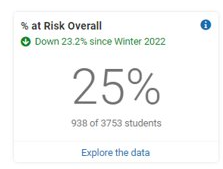What’s new in Renaissance Star CBM Reading this fall?
Renaissance Star CBM assessments continue to evolve to provide educators with additional data and critical insights to measure student performance and track growth.
We are excited to share the following enhancements now included in Star CBM Reading.
New measures added to the Star CBM Data Insights Dashboard
Administrators and teachers use the Star CBM Data Insights Tiles to get answers related to screening, progress, proficiency, and growth throughout the school year and over multiple years. This data is valuable in helping identify students’ needs, determine areas of strength and weakness, track progress toward long-term goals, and create a path for future success.
When looking at the Proficiency tile, you have the ability to view data at any grade level for screening and additional normed measures. Sight & High-Frequency Words and Encoding are now included in the list of measures that can be viewed.
Using the “Measure” dropdown menu, choose to view data from grade-level screening measures, all measures, all normed measures, or any individual measures to get the data insights you need.

In addition to adding Sight & High-Frequency Words and Encoding to the Data Insights tiles, you can further connect assessment and instruction by accessing instructional resources tied to the skills students need to develop, as indicated by these measures. The Star Record Book allows educators to easily view student performance, set goals, manage groups, access resources, and measure growth—all in one place.

Get deeper insights into student proficiency and growth to determine the best next steps for your students with all the assessment data you need at your fingertips—in the Star Record Book and Star CBM Data Insights.
Overall Risk/Composite Score now available for grades K–2
Administrators needing to provide overall risk/composite scores to meet state reporting requirements can now do so with a new composite score option, available for K–2 students taking Star CBM Reading in English.
Educators can still view a student’s screening performance on single screening measures, but now also have the option to view a composite score, based on results of several normed measures. If your district is using single screening measures per grade and does not have additional state-level reporting requirements for a combined score for several measures, it is not recommended that the overall risk/composite score be used. Measures required to produce the Overall Risk score:

The new overall risk score, by default, is selected to “off.” To display the overall risk/composite score, the District Preference must be set. Click on the Help File to learn more about the Overall Risk Score Preference.
On the Percent at Risk Overall tile, you’ll be able to view data using the overall risk/composite score. As shown in the example below, you’ll be able to answer the question, “How many students are below the 20th percentile, based on their overall risk/composite score?”

The Overall Risk Score is a composite score that provides an overall summary of performance for select Star CBM foundations of literacy measures that are psychometrically useful for providing a combined indicator of risk. For additional information about Overall Risk Score/Percent at Risk Score, please refer to the Help File.
Encoding measure field test now reopened for grades 4–6
To help educators to gain deeper insight into students’ foundational encoding development, and to capture data to provide normed benchmarks, Renaissance is reopening the Encoding measure field test for grades 4-6. This field test will run from September 11, 2023, through the end of the 2023–2024 school year.
Interested in participating? It’s easy!
All existing Star CBM Reading users have year-long access and are encouraged to participate in the field test at no additional cost. There are no special permissions, licensing, or training required.
Simply log in to your Renaissance Home page and click “Record Book and Assessments” under the Star CBM Reading tile. The Encoding field test measures are available when you select the “Encoding, Rapid Naming” tab. Click “Encoding 4-6 Field Test” then choose the grade level desired.

Encoding measures include untimed assessments in which a student translates a spoken word into a written word. Administration of Encoding is available for a whole class (using the same form) or individual students (using different forms). Scores for Encoding measures are represented by a percent correct, not correct per minute.

Because these measures are being field tested, scores do not include benchmarks. Students will receive a raw score displayed in gray, as shown below. Normed benchmarks for grades 4–6 will become available after the year-long field test is completed, beginning at Back-to-School 2024 (data pending).

Passage Oral Reading Percent Accuracy reporting enhancements
The Passage Oral Reading measure assesses both decoding and comprehension and is considered a critical measure of reading fluency.To assist educators in better understanding and reporting their students’ fluency and comprehension, we’ve included both the Correct Per Minute (CPM) and Percent Accuracy score side-by-side. Educators will see these scores, in two places, within the Star Record Book.
Click on the student’s name to see a list of all Star Assessments the student has completed. The Passage Oral Reading measure in Star CBM Reading now includes both CPM and Percent Accuracy scores, as shown below:

You can also view results by simply clicking on the Passage Oral Reading results tile.

We are excited to share these updates and enhancements. Renaissance is dedicated to providing educators with the tools they need to confidently inform instructional decisions to move all students forward.
